Cancer researchers are focusing their efforts on identifying central pathways that trigger or enhance the invasiveness of tumor cells. One such target is EMMPRIN (... Cancer researchers are focusing their efforts on identifying central pathways that trigger or enhance the invasiveness of tumor cells. One such target is EMMPRIN (Extracellular Matrix Metalloproteinase Inducer). It has been shown that EMMPRIN expression is linked to various cell signaling pathways that lead to an increase in tumor cell vascularization. Researchers are focusing efforts on elucidating the role of EMMPRIN in a number of disorders including cancer, arthritis, tissue repair and numerous inflammation-dependent diseases. DESCRIPTION/DETAILS Basigin is a member of the immunoglobulin superfamily thatis also known as EMMPRIN. Human basigin is expressed as two differentiallyspliced isoforms encoded by a single gene found on chromosome, renamedrespectively as basigin-1 and basigin-2. Attempts to demonstrate specifichemophilic on separate cells, or between soluble forms of recombinant basiginusing surface Plasmon resonance have not been successful, suggesting thatbasigin-2 cannot function as a receptor for itself. In order to identify possible receptors for soluble basiginligand, an affinity purification approach was employed. This approach resulted inthe labeling of several potential interacting proteins, and MALDI MS/MSsequencing of one of these proteins identified a novel isoform of human basigin(basigin-3). Immunoprecipitation studies using cell fractions revealed thatrBSG interacts with basigin-2 at the cell membrane, and subsequently interactswith the basigin-3 isoform within the cell. Small-interfering RNA (siRNA)knockdown of basigin-2 protein reduced, but did not eliminate, rBSG-mediatedERK activation in HESCs, suggesting that additional cell surface receptors forsoluble basigin may exist. Taken together, these results support the hypothesisthat basigin-2 can function as a receptor for soluble basigin and demonstratethat the hemophilic interactions between basigin proteins are not dependentupon glycosylation of the basigin ligand. It has also been shown that soluble EMMPRIN binds tomembrane-bound EMMPRIN and the bound complex is internalized presenting apotential means to deliver therapeutic compounds to the cell in a highlytargeted manner. A therapeutic scheme isproposed that aims to design EMMPRIN-conjugates designed to deliver cancertherapeutics in a targeted fashion. ApplicationsConjugation oftherapeutics to EMMPRIN increases specificity and targets cancers cells cancer (skin, bladder,breast); other inflammatory diseases (arthritis, endometriosis); Upregulationof inflammatory response. BenefitsIt is possible to design therapeutic agents directed toward human basigin. Possible therapeutic scheme to block tumor progressionor inflammation. |
Dr. van der Donk from the University of Illinois has characterized expression vectors and a family of proteases that are useful in removing affinity tags after... Dr. van der Donk from the University of Illinois has characterized expression vectors and a family of proteases that are useful in removing affinity tags after protein expression. Affinity tag removal after protein expression is sometimes necessary for the protein of interest to be functional and active. However during this tag removal, some amino acids not native to the protein of interest can be left behind. Dr. van der Donk's invention eliminates the possibility of extraneous amino acids being left on the final protein product, which is an improvement over existing enzymatic tag removal techniques. This invention has identified a class of lanthipeptides, class II LanPs that show substrate specificity and can serve as efficient sequence-specific traceless proteases, expanding and advancing the current toolbox of proteases. The general goal of Dr. van der Donk's research is to understand enzymatic transformations that are of environmental or pharmaceutical importance. The van der Donk lab utilizes both synthetic organic chemistry and molecular biology to reach this goal. Specifically, the lab uses genome mining strategies to discover new natural products, use microbiology and genomic tools to determine their mode of action, use chemical biology techniques to study their biosynthesis, and use synthetic chemistry to improve their activities and therapeutic properties. |
Dr. Metcalf and Dr. van der Donk from the University of Illinois have discovered 12 novel phosphonate natural products as well as the genes responsible for the... Dr. Metcalf and Dr. van der Donk from the University of Illinois have discovered 12 novel phosphonate natural products as well as the genes responsible for the biosynthesis of hundreds of additional compounds of other natural product classes. Phosphonic and phosphinic acids represent an underexploited group of bioactive compounds with great promise for the treatment of human disease. |
A radio frequency (RF) coil comprising a plurality of electrically uninterrupted conductive legs, each leg having a first end and a second end, and at least one... A radio frequency (RF) coil comprising a plurality of electrically uninterrupted conductive legs, each leg having a first end and a second end, and at least one continuous conductor electrically connected to the first ends of the legs. Frequency tuning of the coil is achieved by translating, along the legs, an electrically continuous tuning band that includes a capacitor closed about the axis of the coil in proximity to the conductive legs. Maintaining electrical symmetry of the coil results in tuning ranges of at least 30 percent of the nominal value of the resonant frequency. |
Dr. Kuhlman from the University of Illinois at Urbana-Champaign has created a new system that provides a single editing tool for a variety of genome modifications... Dr. Kuhlman from the University of Illinois at Urbana-Champaign has created a new system that provides a single editing tool for a variety of genome modifications. This method has the advantage over CRISPR-Cas9 system in not requiring prior modification of the genome and requires only locus-specific primers for genome editing. This technology is an optimized Landing Pad system that can use positive and negative selection to select for insertion, deletion, and knockout events at genomic targets using specific primers contain homology region A, B, and C. This approach provides a powerful tool for manipulating the genome. Benefits- The Landing-Pad system can integrate large fragments of DNA, can be targeted anywhere in the genome and ab be applicable to deletions and knockouts as well.
- Unlike the CRISPR-Cas9 system, this technique does not require a special promoter for gene expression.
- The Landing-Pad system can target different loci with only locus-specific primer design.
|
Medical professionals need techniques that will help them diagnose diseases before debilitating symptoms begin to manifest in patients. Point of care testing, or... Medical professionals need techniques that will help them diagnose diseases before debilitating symptoms begin to manifest in patients. Point of care testing, or bedside testing, enables rapid diagnostic tests to be performed at a patient's bedside. Benefits include: - Immediate data, which can be interpreted by nurse or trained technician
- Decreased cost and effort, which could dramatically increase frequency of patient testing
- Cost-effective method to produce patient biomarker profile
Dr. Bashir's lab has invented a label-free, electronic method for quantifying various biomarkers from blood. This method may be incorporated into a portable handheld device which enables healthcare professionals to perform complete blood count diagnostics at the point of patient care. Key advantages over existing competing technology include versatility, scalability, and decreased cost of production. |
Dr. Bashir has developed a walking biological machine. This "bio-bot" can move spontaneously, and may be useful for sensing, information processing, transport,... Dr. Bashir has developed a walking biological machine. This "bio-bot" can move spontaneously, and may be useful for sensing, information processing, transport, protein expression and actuation applications. |
Researchers from the University of Illinois have identified a new, cheaper and easier way to detect methylation (alterations) of DNA. By measuring the methylation... Researchers from the University of Illinois have identified a new, cheaper and easier way to detect methylation (alterations) of DNA. By measuring the methylation of certain DNA sequences, doctors can predict the likelihood of cancers and other disorders. This early detection has the potential to save lives. |
Researchers and practitioners in university, industrial and national labs increasingly rely on low temperatures in the development and study of products. For... Researchers and practitioners in university, industrial and national labs increasingly rely on low temperatures in the development and study of products. For example, pharmaceutical companies routinely use low temperatures to study disease targets and markers. The biomolecules are always in buffers. Since the pH of buffers changes dramatically upon lowering temperature, the biolmolecules are not the same pH when they are at the room temperature. The change of pH can dramatically change the structural and functional properties of the biomolecules so that information obtained at low temperature does not reflect its properties at room temperature or physiological temperature. Additionally, since the exact pH buffer at different temperatures is not often predictable, the results obtained using a temperature variable pH buffer cannot easily correlate back to the pH at room temperature. This invention is a new design of pH buffers that show negligible pH change upon cooling to low temperatures, including cryotempatures. This invention solves the problem of significant change in apparent pH of a glycerol solution of common biological buffers upon cooling to cryotemperature. By combining a buffer that increases pH upon cooling with one that decreases pH upon cooling, the apparent pH change upon cooling to cryotemperature is minimized. |
Prof. Oelze from the University of Illinois has developed a novel technique of processing ultrasound images which will improve the spatial resolution by a factor... Prof. Oelze from the University of Illinois has developed a novel technique of processing ultrasound images which will improve the spatial resolution by a factor of 6.9 (at least) over the diffraction limited approaches. It will also provide significant noise reduction. |
Dr. Boppart from the University of Illinois has developed new computational algorithms to improve Optical Coherence Tomography (OCT) imaging. This will provide... Dr. Boppart from the University of Illinois has developed new computational algorithms to improve Optical Coherence Tomography (OCT) imaging. This will provide surgeons with a better view of cancerous tissue and allow improved treatment of numerous diseases. |
A system that incorporates teachings of the present disclosure may include, for example, an ionizing radiation sensor having a first scintillator for generating... A system that incorporates teachings of the present disclosure may include, for example, an ionizing radiation sensor having a first scintillator for generating photons from incoming ionizing radiation, an imaging intensifier for amplifying the photons, and an electron-multiplying charge-coupled device (EMCCD) coupled to the imaging intensifier for sensing the amplified photons generated by the imaging intensifier. |
A system that incorporates teachings of the present disclosure may include, for example, a sensor having a pulse oximeter sensor to measure an oxygen saturation... A system that incorporates teachings of the present disclosure may include, for example, a sensor having a pulse oximeter sensor to measure an oxygen saturation level in a liquid, a magnetic source coupled to the pulse oximeter sensor, and a controller to control the pulse oximeter sensor and the magnetic source, and to measure a mechanical effect on the liquid responsive to the magnetic source applying a magnetic field to the liquid. |
An apparatus and method for estimating and imaging mechanical properties of biological tissues. The apparatus includes one or two ultrasound emitting devices (... An apparatus and method for estimating and imaging mechanical properties of biological tissues. The apparatus includes one or two ultrasound emitting devices (transducers) that first apply an acoustic radiation force to vibrationally displace a sphere embedded in the medium. Alternatively, a biopsy needle may be inserted into the medium and vibrated along its axis to generate shear waves. During and after vibration, ultrasound is again applied to image shear waves in the medium that propogate from the vibrating sphere or needle. By measuring the local wavelength of the shear waves, the shear modulus and viscous coefficient of the medium surrounding the vibrating element are estimated. |
A system and method for designing RF pulses for multi-channel and/or multi-dimensional spatially-selective applications using a linear approximation. Embodiments... A system and method for designing RF pulses for multi-channel and/or multi-dimensional spatially-selective applications using a linear approximation. Embodiments of the system and method may use a generalized linear-class large tip angle approximation to design RF pulses for multi-channel and parallel transmission. Further, some of these approximations allow for the design of arbitrarily large flip angles, irregularly-shaped flip angle profiles, or arbitrary initial magnetization values. Embodiments of the system and method may also provide for the design of k-space trajectories which aid in maintaining assumptions of the various linear class approximations. |
Current super-resolution microscopy techniques require special laser setups and fluorescent molecules (such as PALM and STORM) that allow the fluorophores to be... Current super-resolution microscopy techniques require special laser setups and fluorescent molecules (such as PALM and STORM) that allow the fluorophores to be turned on and off so that only a small number of fluorophores are turned on at any time. With the Super Shrimp image analysis algorithm, super-resolution images can be created from images with high densities of fluorophores. The invention creates microscopy images that have 5 or more times better resolution than standard microscopy images while using the standard microscopic set up available in most laboratories. It allows use of any fluorescent molecule (including quantum dots) that blinks or photobleaches to pick fluorophores out of the fluorescent background, and it can work with thousands of fluorophores in an image. This image analysis algorithm can localize quantized drops in fluorescence even with a background to create super-resolution images from standard photobleaching movies. It does not require special photo-switchable fluorophores (PALM, STORM) or fluorophores with long-lived dark states (dSTORM). The data acquisition is accomplished in minutes instead of hours and it can use standard laboratory microscopic set up with any fluorescent molecule. The algorithm processes a movie in which fluorescent molecules or particles are photobleaching or blinking and looks for individual photobleaching events that can be located with high resolution (i.e. the position of the fluorescent molecules). A composite image with resolution much higher than the original movie can then be generated. Noise is reduced by rejecting fluorophores that are poorly fit by a Gaussian and frames are averaged. BenefitsThe image analysis algorithm to create super-resolution images using standard photobleaching and blinking movies provides the following benefits: - Uses standard laboratory equipment.
- Enables sub-cellular structure examination
- Can be used with any fluorescent molecule that can be detected by a CCD camera. It can use high labeling densities
- Fast data acquisition
|
Advanced molecular imaging tools combined with investigative tools like biochemical and cell based assays have thepotential to unravel complex molecular processes... Advanced molecular imaging tools combined with investigative tools like biochemical and cell based assays have thepotential to unravel complex molecular processes. These tools combined with high throughput screening can significantly impact diagnostics for cancer screening and accelerate drug discovery. These inventions are two new Fluorescence Resonance Energy Transfer (FRET) biosensor pairs, one composed of two new colors, mOrange2 and mCherry and the other composed of a modified high-sensitive ECFP/YPet pair that can significantly enhance the dynamic range of a variety of biosensors. The ECFP/YPet can detect signaling events with high spatio-temporal resolutions which makes it an ideal readout indicator for high throughput screening. FRET technology and genetically encoded FRET biosensors are very useful in detecting active molecular events inlive cells with high temporal and spatial resolutions. FRET occurs when two flurophores are in proximity with the emission spectrum of the donoroverlapping with the excitation spectrum of the acceptor. To date, the most popular FRET pair is cyan and yellow fluorescent proteins (CFP and YFP). The new FRET biosensor pairs mOrange2/mCherry are proteins with different colors and spectrally distinctive from the CFP/YFP pair. This invention opens up the possibility of lighting two diagnostic biomarkers in the same cell e.g., cancer cells, thus providing a double criterion high-fidelity assay to differentiate cancer vs. normal cells. To provide proof-of-concept that mOrange2 and mCherry are suitable as novel FRET biosensors, they were operably linked to the protein recognition sequence of MMP-MT1. MMP-MT1 is an enzyme belonging to the matrix metalloproteinase family that has known roles in cancer metastasis. The basis of this assay is that when MT1-MMP is inactive, the mCherry and mOrange2 and positioned in proximity and favor a strong FRET between the two moieties. Indeed, in-vitro assays established that the mOrange/mCherry pair can serve as a reliable and sensitive indicator of the status of MT1-MMP activation and can potentially be applied to other biomarker assays. The ECFP/YPet pair provides a high-sensitive biosensor for the visualization of molecular hierarchy at different subcellular locations inlive cells. In-vitro assays revealedthat the ECFP/YPet pair exhibits significantly enhanced dynamic range of the MT1-MMP biosensor compared to currently available CFP/YFP FRET pairs. When quantified, the ECFP/YPet pair showed a 570% change (% change in basal level upon stimulation of MT1-MMP) when compared to only 90-100% in existing FRET pairs. The ECFP/YPet pair has also been successfully applied to other classes of proteins, like kinases, that are important therapeutic targets in human cancer. These and other genetically engineered biosensors can serve as a research tool to monitor different signaling cascades in live mammalian cells with high sensitivity. The developed MT1-MMP biosensor and potentially other protein biosensors can provide a powerful tool for the spatiotemporal imaging of protein functions in cancer development e.g. detection of circulating tumor cells (CTCs). Furthermore, these biosensors can serve as an excellent high-throughput reporting system forthe detection of cancer and the development of inhibitors for cancer therapeutics. BenefitsThe novel mOrange2/mCherry pair presents a method to simultaneously visualize two active signaling events in the same cell when combined with existing FRET pairsThe ECFP/YPet pair can serve as a high-sensitive biosensor with significantly enhanced dynamic ranges compared to existing CFP/YFP FRET pairs. The ECFP/Ypet pair can be operably linked to any protein recognition sequence to detect activity of that protein in live cells. The pair also includes a positively charged tag which allows 100% efficiency ofdetection. This invention demonstrates an ECFP/Ypet pair operably linked to MT1-MMP, a tumor metastasis biomarker, to accurately detect circulating tumor cells in blood samples. |
Tremendous potential exists for helical polypeptides that are water soluble (ionic) and remain stable at physiological conditions,... Tremendous potential exists for helical polypeptides that are water soluble (ionic) and remain stable at physiological conditions, variable environmental conditions including pH fluctuations, temperature changes, and in the presence of denaturing agents for gene delivery and cell-membrane penetration over commercially available products. Libraries of helical polypeptides are screened for desired traits, i.e. efficient gene transfection compared to standard transfection reagents. |
Dr. John Rogers from the University of Illinois at Urbana-Champaign has developed bioresorbable silicon electronics that can be used for real-time sensing of neural... Dr. John Rogers from the University of Illinois at Urbana-Champaign has developed bioresorbable silicon electronics that can be used for real-time sensing of neural electrical activity. This invention could prevent follow-up neural surgeries, and has potentials for long-term monitoring of patients. |
Dr. Hergenrother from the University of IL has developed a novel antibiotic that is effective against certain antibiotic-resistant gram-negative bacteria. His powerful... Dr. Hergenrother from the University of IL has developed a novel antibiotic that is effective against certain antibiotic-resistant gram-negative bacteria. His powerful predictive algorithm determines accumulation of molecules in Gram-negative bacteria and enables conversion of known Gram-positive only antibiotics into novel compounds with Gram-negative potency. |
Dr. Ying Diao has identified a new nanoporous thin film fabrication method using simple solution processing methods applicable to both polymer... Dr. Ying Diao has identified a new nanoporous thin film fabrication method using simple solution processing methods applicable to both polymer and small molecule semiconductors. Using the novel additive method, she has developed a OFET chemical sensors comprising of nanoporous thin film. Templated by the nanostructured PVP:HAD layer, the pore sizes in the semiconductor layer are widely tunable from 50 nm to 1µm. Compared to the currently available sensors, the invention exhibited ultrafast and ultrasensitive response to ammonia as well as formaldehyde molecules down to 1ppb at hundred-millisecond time scale, a breakthrough of 10-fold sensitivity enhancement. The excellent performance, simple fabrication, and diverse form-factors of nanoporous transistors has opened up a wide range of applications of the invention in the fields of personal health and environmental monitoring, both fields which demand sensors with high sensitivity on the ppb level with fast response. 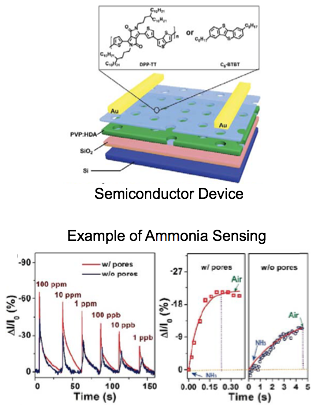
|
Dr. Rashid Bashir has developed a process for manufacturing modular bioactuators. The process utilizes stereolithographic 3D printing to create injection... Dr. Rashid Bashir has developed a process for manufacturing modular bioactuators. The process utilizes stereolithographic 3D printing to create injection molds for cell/hydrogel cultures and for skeletal scaffolds for the actuators. The resulting ring-like actuators can then be manually placed on the scaffold. This introduces a modular design that is customizable and transferable. These actuators are also triggered optogenetically and exhibit directional motion and 2D steering. |
Dr. Metcalf from the University of Illinois at Urbana-Champaign has developed a novel method for genome editing in archaea utilizing the Cas9 system. This method utilizes... Dr. Metcalf from the University of Illinois at Urbana-Champaign has developed a novel method for genome editing in archaea utilizing the Cas9 system. This method utilizes Cas9 machinery with the native archaeal HDR mechanism to edit the genome with no off-target activity. This method can also be combined with archaeal NHEJ machinery to allow random mutagenesis at a location of interest. Notably these tools allow efficient genome editing in methanogenic species potentially leading to novel biogenic strategies for methane production. 
|
Dr. Liang from the University of Illinois at Urbana-Champaign has developed new MRI acquisition methods and post-acquisition data processing techniques that allow for a... Dr. Liang from the University of Illinois at Urbana-Champaign has developed new MRI acquisition methods and post-acquisition data processing techniques that allow for a standard MRI instrument to perform traditional spin density imaging as well as susceptibility mapping, quantitative susceptibility mapping, and metabolite mapping with high resolution and signal to noise ratio from a single scan. Unlike other techniques, such as CT scans, the current technology does not require ionizing radiation and is thus safer for patients and radiology professionals. 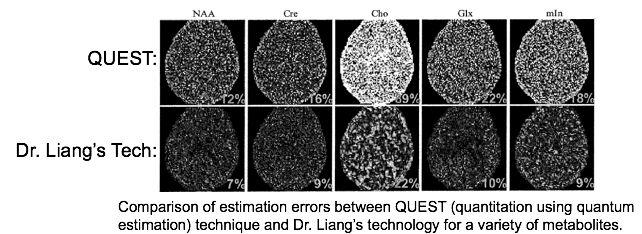
|
Professor Insana from the University of Illinois at Urbana-Champaign has developed an information based technique to determine the... Professor Insana from the University of Illinois at Urbana-Champaign has developed an information based technique to determine the mechanical properties of soft biological media. This technique has been adapted from the Auto-progressive algorithm that was originally developed for civil engineering applications. This algorithm is a unique combination of Force Displacement, Finite Element Algorithm (FEA), and Artificial Neural Network (ANN) along with what to sample and where to look. It is better than the inverse analysis or dynamic imaging techniques in that it has a machine learning aspect which eliminates the need of making any initial assumptions about the media being imaged. The technology has a lot of potential in non-linear imaging and is not tied to any one particular type of imaging technique. Its primary application is in ultrasound imaging. |
Dr. Aksimentiev from the University of Illinois at Urbana-Champaign, with colleagues at Northeastern and University of North Carolina,... Dr. Aksimentiev from the University of Illinois at Urbana-Champaign, with colleagues at Northeastern and University of North Carolina, has developed multiplex detection platform for general biomarker sensing. This platform uses nanopore-based fingerprinting of nucleic acid nanoparticles to detect the presence of biomarkers. Using a single nanoparticle kit, this invention makes it possible to detect a variety of biomarkers and, thus, diagnose a variety of health conditions. The primary application for this biomarker sensing platform is in the diagnosis of health conditions (e.g., cancer). Additional applications include encryption for homeland security and biodefense. 
|
Dr. Aditi Das from the University of Illinois at Urbana-Champaign has developed a novel set of therapeutic endocannabinoid derivatives.... Dr. Aditi Das from the University of Illinois at Urbana-Champaign has developed a novel set of therapeutic endocannabinoid derivatives. These derivatives retain the anti-inflammatory, anti-cancerous, anti-angiogenic, and anti-platelet aggregatory properties while having an increased half life. As these compounds are based off endogenous endocannabinoids it is predicted side-effects will be miminal. Importantly these derivatives show enhanced anti-migratory properties compared to the endogenous compound suggesting they will act as potent drugs. 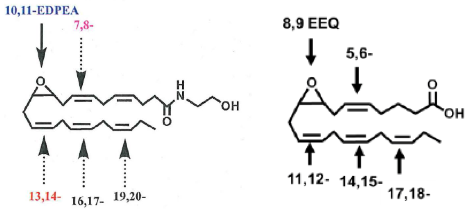
|
Therapeutic endocannabinoid derivatives showing an increased half-life and enhanced anti-migratory properties. These compounds retain the anti-inflammatory, anti-cancerous... Therapeutic endocannabinoid derivatives showing an increased half-life and enhanced anti-migratory properties. These compounds retain the anti-inflammatory, anti-cancerous, anti-angiogenic, and anti-platelet aggregatory properties and are predicted to have minimal side-effects. 
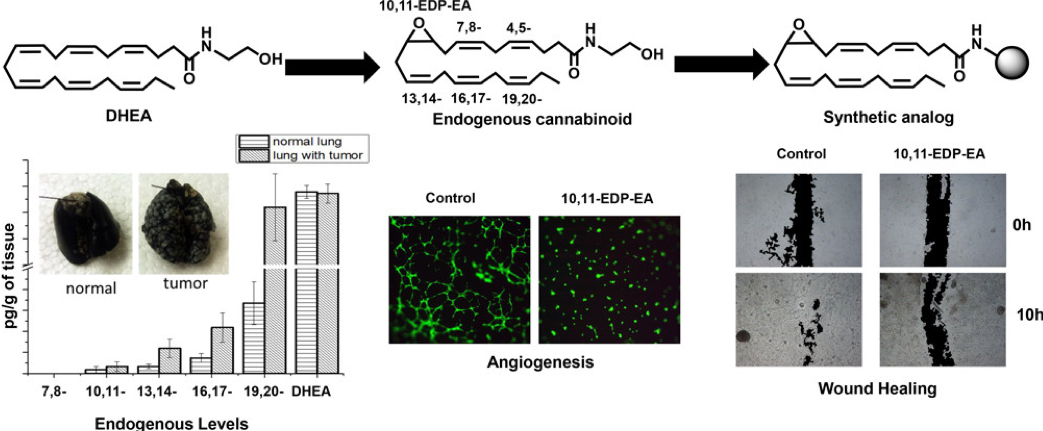
|
A scalable device design of a dense array of multiple 2D nanopores made from nanoscale semiconductor materials to simultaneously detect multiple DNA strands and identify... A scalable device design of a dense array of multiple 2D nanopores made from nanoscale semiconductor materials to simultaneously detect multiple DNA strands and identify translocations of many biomolecules in a massively parallel detection scheme. The technology is based on the variation of the transverse sheet current across each membrane. The electronic sensing across the nanopore membrane offers a higher detection resolution compared to ionic current blocking technique in a multi-pore setup, irrespective of the irregularities that occur while fabricating the nanopores in a 2D membrane. 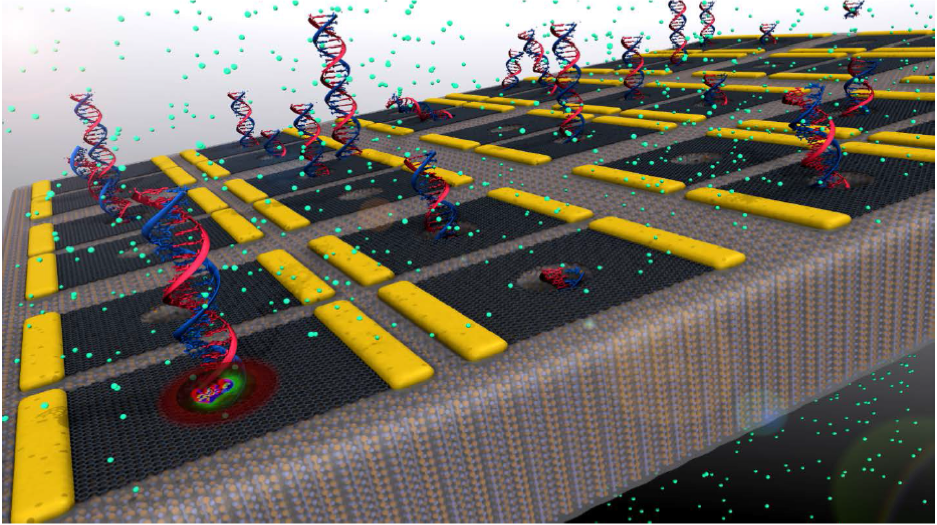
|
Researchers from University of Illinois have advanced the field of robotic surgery by introducing haptic feedback based on the 3D point cloud reconstruction technique. The... Researchers from University of Illinois have advanced the field of robotic surgery by introducing haptic feedback based on the 3D point cloud reconstruction technique. The point cloud can be seen in the display and the doctor receives a feedback if the tip of the tool touches any unexpected region or with too great a force. The application has great potential since a small mistake can lead to death due to excessive bleeding. 
|


